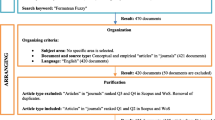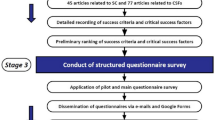Abstract
In the field of multi-attribute group decision-making (MAGDM), “decision-making trial and evaluation laboratory” (DEMATEL) is a popular method that has been deployed to discover hidden relationships among many inter-twined factors of numerous real-world problems. This paper discusses several limitations of the DEMATEL method in mining the causal relationships and ranking the factors. Also, in this paper, we develop a novel decision-making framework that will be able to overcome the issues found in the DEMATEL method and tackle both formal and informal decisions. This model, which we call “Causal Relationship and Ranking Technique (CRRT)”, uses a data-deterministic expert weighing setup rather than assigning equal weights or pre-defined weights to each expert. The model proposes a better technique to mine factor inter-relations and proposes two new types of digraphs portraying the causal inter-relationships among the factors, and also proposes a new two-step factor ranking method based on the derived causal relationships. The intuitionistic fuzzy setting is considered in this work in order to capture the uncertainty of expert opinions. Furthermore, our proposed framework is applied to a real-life case study on discovering various factors of a high school administration, that have a significant influence on students’ performance. Comparison with standard methods such as TOPSIS and VIKOR for student performance data and also some other datasets such as supplier selection data, and sustainability data proves that the model is able to rank the factors better than the existing models.






Similar content being viewed by others
References
Abdullah L, Pinxin G (2019) Decision making method based on Pythagorean fuzzy sets and its application to solid waste management. Complex Intell Syst 5(2):185–198. https://doi.org/10.1007/s40747-019-0100-9
Abdullah L, Razamin R (2020) Developing a causal relationship among factors of e-commerce: a decision making approach. J King Saud Univ Comput Inf Sci 32(10):1194–1201. https://doi.org/10.1016/j.jksuci.2019.01.002
Abdullah L, Zheeching O, Nuraini R (2021) An intuitionistic fuzzy decision-making for developing cause and effect criteria of subcontractors selection. Int J Comput Intell Syst 14(1):991–1002. https://doi.org/10.2991/ijcis.d.210222.001
Addae B, Wang W, Xu H (2021) Sustainable evaluation of factors affecting energy-resource conflict in the western region of ghana using large group-DEMATEL. Group Decis Negot 30:847–877. https://doi.org/10.1007/s10726-021-09737-y
Atanassov KT (1986) Intuitionistic fuzzy sets. Fuzzy Sets Syst 20(1):87–96. https://doi.org/10.1016/s0165-0114(86)80034-3
Bai C, Sarkis J (2013) A grey-based DEMATEL model for evaluating business process management critical success factors. Int J Prod Econ 146(1):281–292
Baradwaj B, Pal S (2011) Mining educational data to analyze students' performance. Int J Adv Comput Sci Appl 2(6)
Büyüközkan B, Fethullah G (2017) Application of a new combined intuitionistic fuzzy MCDM approach based on axiomatic design methodology for the supplier selection problem. Appl Soft Comput 52:1222–1238
Cebi S (2013) Determining importance degrees of website design parameters based on interactions and types of websites. Decis Support Syst 54(2):1030–1043. https://doi.org/10.1016/j.dss.2012.10.036
Chang B, Chang C-W, Wu C-H (2011) Fuzzy DEMATEL method for developing supplier selection criteria. Expert Syst Appl 38(3):1850–1858. https://doi.org/10.1016/j.eswa.2010.07.114
Spearman Rank Correlation Coefficient (2008) In The concise encyclopedia of statistics. Springer, New York, pp 502–505. doi:https://doi.org/10.1007/978-0-387-32833-1_379
Dey A, Senapati T, Pal M, Chen G (2020) A novel approach to hesitant multi-fuzzy soft set-based decision-making. AIMS Math 5:1985–2008
Dymova L, Sevastjanov P (2012) The operations on intuitionistic fuzzy values in the framework of Dempster-Shafer theory. Knowl-Based Syst 35:132–143
Esfandiari M, Rizvandi M (2014) An application of TOPSIS method for ranking different strategic planning methodology. Manage Sci Lett. https://doi.org/10.5267/j.msl.2014.6.022
Fontela E, Gabus (1976) The DEMATEL Observer. Battelle Geneva Research Center.
Gabus, Fontela E (1972) World problems, an invitation to further thought within the framework of DEMATEL. Battelle Geneva Research Center
Gao Z, Liang RY, Xuan T (2019) VIKOR method for ranking concrete bridge repair projects with target-based criteria. Result Eng. https://doi.org/10.1016/j.rineng.2019.100018
Govindan K, Khodaverdi R, Vafadarnikjoo A (2015) Intuitionistic fuzzy based DEMATEL method for developing green practices and performances in a green supply chain. Expert Syst Appl 42(20):7207–7220. https://doi.org/10.1016/j.eswa.2015.04.030
Kahraman C, Onar S, Oztaysi B, Sari I, Cebi S, Tolga A (Eds) (2020). Intelligent and fuzzy techniques: smart and innovative solutions, 1 edn. Springer, Cham. Doi: https://doi.org/10.1007/978-3-030-51156-2
Kaya R, Yet B (2019) Building Bayesian networks based on DEMATEL for multiple criteria decision problems: a supplier selection case study. Expert Syst Appl 134:234–248. https://doi.org/10.1016/j.eswa.2019.05.053
Khazai B, Merz M, Schulz C (2013) An integrated indicator framework for spatial assessment of industrial and social vulnerability to indirect disaster losses. Nat Hazards 67:145–167
Koca G, Egilmez O, Akcakaya O (2021) Evaluation of the smart city: Applying the dematel technique. Telematics Inform. https://doi.org/10.1016/j.tele.2021.101625
Kozik R (2016) Using a fuzzy DEMATEL method for analyzing the factors influencing subcontractors’ selection. AIP conference proceedings, 1738
Liu H-C, Liu L, Li P (2014) Failure mode and effects analysis using intuitionistic fuzzy hybrid weighted Euclidean distance operator. Int J Syst Sci 45(10):2012–2030. https://doi.org/10.1080/00207721.2012.760669
Panaihfar F, Heavey C, Byrne PJ (2015) Developing retailer selection factors for collaborative planning, forecasting and replenishment. Ind Manag Data Syst 115(7):1292–1324. https://doi.org/10.1108/imds-01-2015-0009
Patil SK, Kant R (2014) A hybrid approach based on fuzzy DEMATEL and FMCDM to predict success of knowledge management adoption in supply chain. Appl Soft Comput 18:126–135. https://doi.org/10.1016/j.asoc.2014.01.027
Peleckis K (2021) Application of the DEMATEL model for assessing IT sector’s sustainability. Sustainability. https://doi.org/10.3390/su132413866
Puka L (2011) Kendall’s Tau. In: Lovric M (ed) International encyclopedia of statistical science. Springer, Berlin. https://doi.org/10.1007/978-3-642-04898-2_324
Rouyendegh BD (2012) Evaluating projects based on intuitionistic fuzzy group decision making. J Appl Math. https://doi.org/10.1155/2012/824265
Saa AA (2016) Educational data mining & students’ performance prediction. Int J Adv Comput Sci Appl 7(5)
Saaty T (1990) How to make a decision: The analytic hierarchy process. Eur J Oper Res 48(1):9–26. https://doi.org/10.1016/0377-2217(90)90057-I
Senapati T, Yager R (2019) Fermatean fuzzy weighted averaging/geometric operators and its application in multi-criteria decision-making methods. Eng Appl Artif Intell 85:112–121. https://doi.org/10.1016/j.engappai.2019.05.012
Shen F, Ma X, Li Z, Xu Z, Cai D (2018) An extended intuitionistic fuzzy TOPSIS method based on a new distance measure with an application to credit risk evaluation. Inf Sci 428:05–119. https://doi.org/10.1016/j.ins.2017.10.045
Si S-L, You X-Y, Liu H-C, Zang P (2018) DEMATEL technique: a systematic review of the state-of-the-art literature on methodologies and applications. Math Problems Eng, pp 1–33
Szmidt E, Kacprzyk J (2014) A similarity measure for intuitionistic fuzzy sets and its application in supporting medical diagnostic reasoning. Artifical Intelligence and Soft Computing–ICAISC, pp 388–393
Tafreshi P, Aghdaie M, Behzadian M (2016) Developing a group decision support system for advertising media evaluation: a case in the middle east. Group Decis Negot 25:1021–1048. https://doi.org/10.1007/s10726-015-9464-4
Tsai W, Yang C, Leu J (2013) An integrated group decision making support model for corporate financing decisions. Group Decis Negot 22:1103–1127. https://doi.org/10.1007/s10726-012-9308-4
Xiao J, Wang X, Zhang H (2022) Exploring the ordinal classifications of failure modes in the reliability management: an optimization-based consensus model with bounded confidences. Group Decision Negot 31:49–80. Retrieved from https://doi.org/10.1007/s10726-021-09756-9
Xu Z (2010) A deviation-based approach to intuitionistic fuzzy multiple attribute group decision making. Group Decis Negot 19:57–76
Yadav S, Pal S (2012) Data mining: a prediction for performance improvement of engineering students using classification. World Comput Sci Inform Technol J 2(2)
Yue Z (2014) TOPSIS-based group decision-making methodology in intuitionistic fuzzy setting. Inf Sci. https://doi.org/10.1016/j.ins.2014.02.013
Zadeh L (1965) Fuzzy sets. Inf Control 8(3):338–353. https://doi.org/10.1016/s0019-9958(65)90241x
Zhang H, Dong Y, Xiao J, Chiclana F, Herrera-Viedma E (2020) Personalized individual semantics-based approach for linguistic failure modes and effects analysis with incomplete preference information. IISE Trans 52(11):1275–1296. https://doi.org/10.1080/24725854.2020.1731774
Zhang H, Wang F, Dong Y, Chiclana F, Herrera-Viedma E (2022) Social trust driven consensus reaching model witha minimum adjustment feedback mechanism considering assessments-modifications willingness. IEEE Trans Fuzzy Syst 30(6):2019–2031. https://doi.org/10.1109/TFUZZ.2021.3073251
Zulkifli N, Abdullah L (2018) Intuitionistic fuzzy DEMATEL for municipal solid waste treatment technologies. Int J Eng Technol 7:710–712
Acknowledgements
The authors of this paper would like to express their sincere gratitude to all the teachers and professors who have actively participated in the survey conducted for the data collection for this research work. Suvojit Dhara acknowledges the support through the prime minister research fellowship (PMRF) which immensely helped in the research work.
Author information
Authors and Affiliations
Corresponding author
Ethics declarations
Conflict of interest
The authors declare that they have no known conflict of financial interests or personal relationships that could have appeared to influence the work reported in this paper.
Additional information
Publisher's Note
Springer Nature remains neutral with regard to jurisdictional claims in published maps and institutional affiliations.
Rights and permissions
Springer Nature or its licensor (e.g. a society or other partner) holds exclusive rights to this article under a publishing agreement with the author(s) or other rightsholder(s); author self-archiving of the accepted manuscript version of this article is solely governed by the terms of such publishing agreement and applicable law.
About this article
Cite this article
Dhara, S., Goswami, A. Causal Relationship and Ranking Technique (CRRT): A Novel Group Decision-Making Model and Application in Students’ Performance Assessment in Indian High School Context. Group Decis Negot 32, 835–870 (2023). https://doi.org/10.1007/s10726-023-09827-z
Accepted:
Published:
Issue Date:
DOI: https://doi.org/10.1007/s10726-023-09827-z




